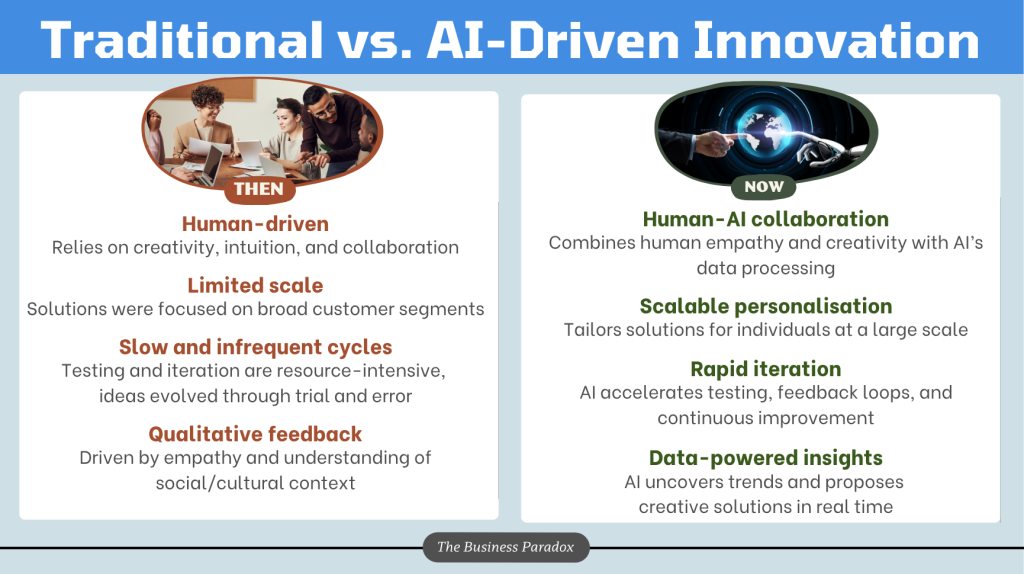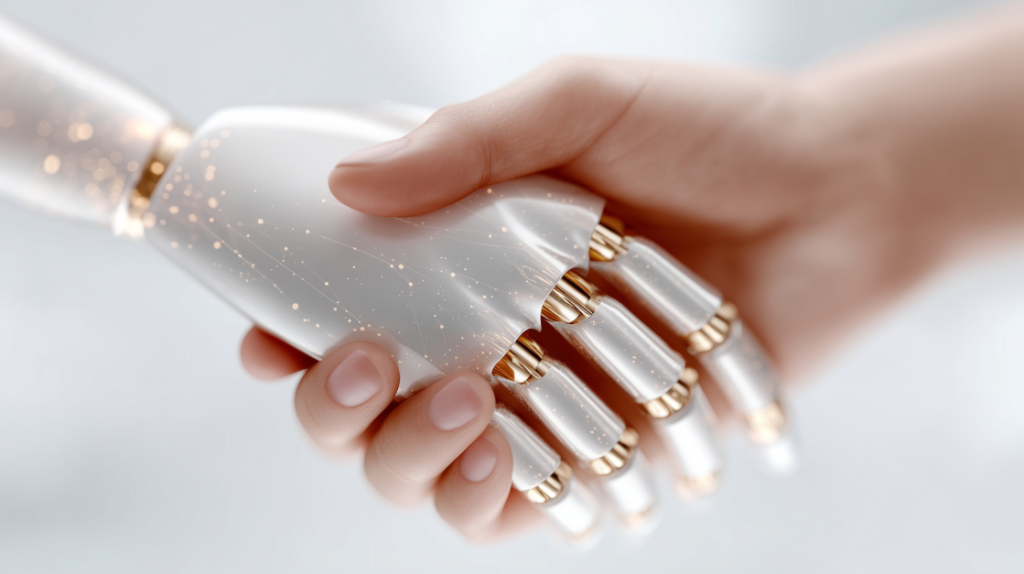AI Is Driving a New Era of Innovation
Artificial Intelligence (AI) is transforming innovation by moving into areas once thought to be uniquely human, such as creative thinking and design. While many leaders focus on AI’s role in optimising operations—cutting costs, streamlining processes, and enhancing customer experiences—its impact goes far deeper. Through the automation of repetitive tasks and rapid pattern recognition, AI has the ability to craft highly personalised solutions and resolve complex problems more efficiently than human teams. Traditionally, innovation relied on human imagination and intuition. In the current innovation landscape, AI co-creates—generating ideas, visuals, and prototypes alongside humans. By rapidly testing and refining countless design options, AI rapidly speeds up innovation cycles and expands what’s possible. This shift challenges businesses to rethink innovation. While AI does not replace the human touch and empathy that drive meaningful change, it enhances and amplifies human ingenuity.
Leaders must reconsider how innovation happens and their evolving role in guiding it. AI alone cannot produce novel and groundbreaking ideas; its real strength lies in inspiring and enhancing human creativity, enabling teams to design and solve problems in new ways. To stay competitive, business leaders must learn to harness AI’s power while keeping innovation human-centered. AI can accelerate your business, but it relies on human imagination and emotional intelligence to ensure that products and services continue to resonate with customers. Equally important, human oversight is essential to ensure the ethical use of AI, particularly when decisions made by algorithms carry significant social or moral implications. If you’re wondering how AI will change your business, the answer isn’t about replacing people—it’s about redefining how your teams innovate and how you lead in this new era.
Innovation Before AI: The Power of Human Collaboration
Before AI transformed the landscape, innovation was a deeply human process rooted in creativity, intuition and collaboration. Individuals and teams relied on their own cognitive abilities, personal experiences, and imagination to come up with new ideas. Brainstorming sessions were central to innovation—spaces where diverse perspectives were shared, challenged, and refined through conversation. People identified problems, spotted patterns, and explored solutions using critical thinking and empathy. They understood their users, aligned ideas with organisational values, and worked together to create meaningful change.
However, this traditional approach had its limits. Creating personalised solutions for every individual was challenging and resource-intensive, so businesses often relied on designing for broad customer groups. Testing ideas, gathering feedback, and iterating took time—slowing down innovation cycles and making it hard to keep pace with shifting markets and customer needs. Ideas developed through multiple rounds of trial and error, shaped by human intuition, expertise, and lived experience. While this method could produce powerful insights, it demanded considerably more time and effort than today’s AI-driven alternatives.
Yet, it had strengths that AI still cannot replicate—it was driven by human curiosity, empathy, and a deep understanding of social and cultural context. Innovation is not just about solving problems efficiently; it is about telling compelling stories, understanding what truly matters to people, and imagining how even simple ideas could improve people’s lives. As AI continues to reshape innovation, these uniquely human traits remain vital for ensuring that progress stays thoughtful, inclusive, and genuinely meaningful.

How Companies are Using AI to Innovate
For business leaders looking to harness AI effectively, companies like Airbnb and Netflix offer powerful examples. Both have embedded AI across their platforms—not just to automate tasks, but to deliver highly personalised experiences that drive user satisfaction and loyalty. AI enables these companies to overcome traditional limits of scale and speed. By continuously learning from real-time user data, they can rapidly adapt and iterate. Most importantly, AI helps them design more user-centric experiences, setting a new benchmark for personalised services.
Netflix and Airbnb show that even the most advanced AI-powered platforms require the human touch to create emotionally resonant and ethically grounded experiences. At Netflix, AI personalises nearly every aspect of the user journey—analysing viewing history, searches, and interactions to recommend content. But behind this seamless interface, human designers and UX researchers play a critical role. They bring empathy, cultural understanding, and ethical considerations into the design process, ensuring the platform remains accessible, inclusive, and engaging for a global audience.
Similarly, Airbnb uses AI to match guests with listings, optimise pricing, and surface relevant options based on behaviour and market trends. Yet, the heart of Airbnb’s platform comes from human connection—local hosts who offer hospitality and add personal touches that algorithms can’t deliver. In both companies, AI provides scale and precision, but human insight ensures authenticity, emotional connection, and ethical responsibility. What makes these platforms successful isn’t the smart algorithms, but how they are paired with thoughtful human design and interaction.
Together, Netflix and Airbnb demonstrate how AI can help businesses move beyond one-size-fits-all solutions—delivering more responsive and personalised experiences at scale. For leaders, the takeaway is clear: integrating AI offers a way to better understand and serve your customers.
AI Strengthens, Not Replaces, Human-Centered Innovation
Innovation in an AI-driven world remains fundamentally human. Recent findings from McKinsey’s 2025 AI survey reinforce that AI is a powerful complement to human capabilities, but does not replace it. Since AI lacks emotional intelligence and a deep understanding of social contexts, human roles need to evolve to focus more on applying empathy and ethical judgement to innovation. Business leaders and teams must interpret user needs through a human lens to ensure innovations align with core societal values.
The survey also highlights that successful AI integration depends heavily on strong governance—covering ethics, risk management, accountability, and transparency. Forward-thinking companies recognise that AI is not a substitute but an enabler of human-centered innovation. They are investing in reskilling and upskilling their workforce to work effectively alongside AI tools. It is clear that technology alone will not drive growth, and empowering employees with the relevant skills ensures they remain central to innovation rather than sidelined.
Despite AI’s transformative potential, innovation still depends on human creativity, empathy, and ethical sensitivity. AI should be viewed as a tool that expands possibilities but does not replace human judgement. Leaders must foster environments that nurture collaboration and reflection, blending human strengths with AI’s efficiency. A culture of continuous learning is essential—employees need training not only on AI’s capabilities but also on its limits and ethical challenges. Training should go beyond technical skills to include ethical awareness, bias mitigation, and the social impact of AI. When teams are equipped with this ethical literacy, organisations can develop AI that aligns with human values, not just performance metrics. Promoting ongoing, transparent discussions about AI’s wider impact ensures ethics remain at the forefront as teams innovate and explore new opportunities.
To keep innovation truly human-centered, companies must design AI systems that enhance user experiences and uphold ethical standards.
Key principles for human-centered AI innovation include:
- Transparency: Businesses must ensure AI systems are transparent and explainable. Clear communication about how AI makes decisions helps build user trust and allows stakeholders to understand and collaborate with AI-driven innovations confidently.
- Inclusivity: AI systems should be developed with diverse perspectives and inputs to ensure they serve a wide range of users. By embedding inclusivity into AI design, companies can minimise bias and create solutions that are fair, accessible, and relevant to all.
- Ethical Considerations: Ethical oversight is vital to prevent harm, bias, or privacy breaches. Companies must prioritise fairness, empathy, and accountability to ensure AI promotes positive social impact.

Conclusion: Steering Innovation in the Age of AI
As AI continues to evolve, it is reshaping the nature of innovation. Business leaders have an important choice to make: allow AI to take over the innovation process, or harness it as a powerful tool that enhances human creativity and insight. AI challenges us to rethink how innovation happens and how leadership should adapt, highlighting that success depends on blending advanced technology with the uniquely human qualities of creativity, empathy and ethical reasoning.
Forward-thinking leaders use AI to elevate human potential—fuelling new discoveries and being efficient without compromising on ethics. The key is striking the right balance: leveraging AI’s power in data and automation without losing sight of innovation as a deeply human endeavour rooted in emotional intelligence, imaginative thinking and ethical responsibility.
Stay ahead with exclusive insights! Sign up for our mailing list and never miss an article. Be the first to discover inspiring stories, valuable insights and expert tips – straight to your inbox!




